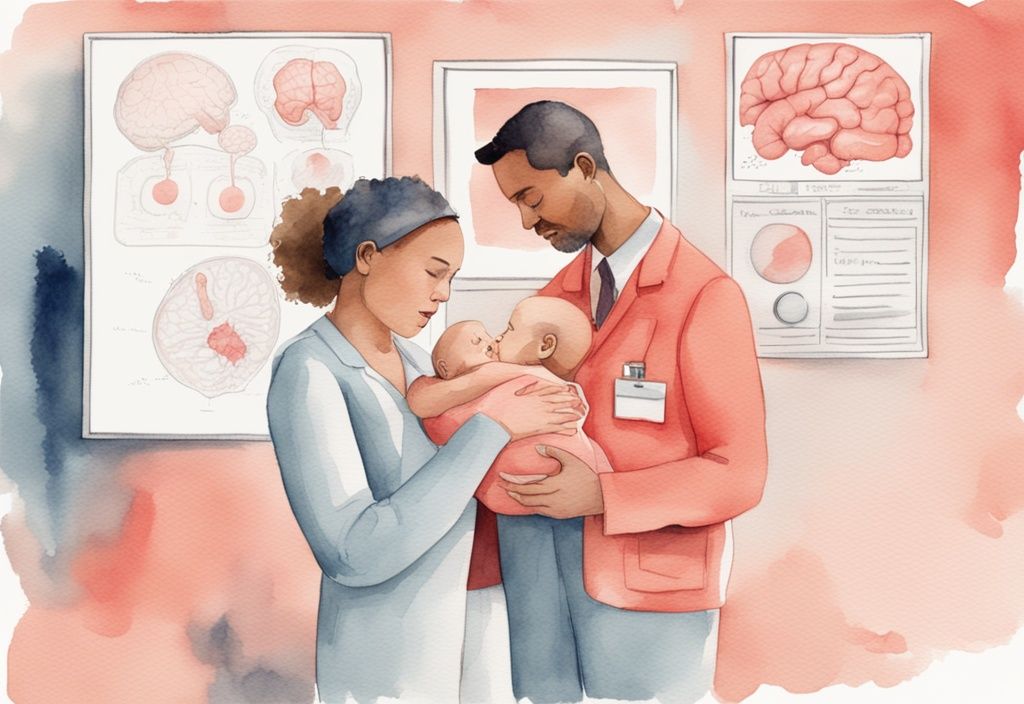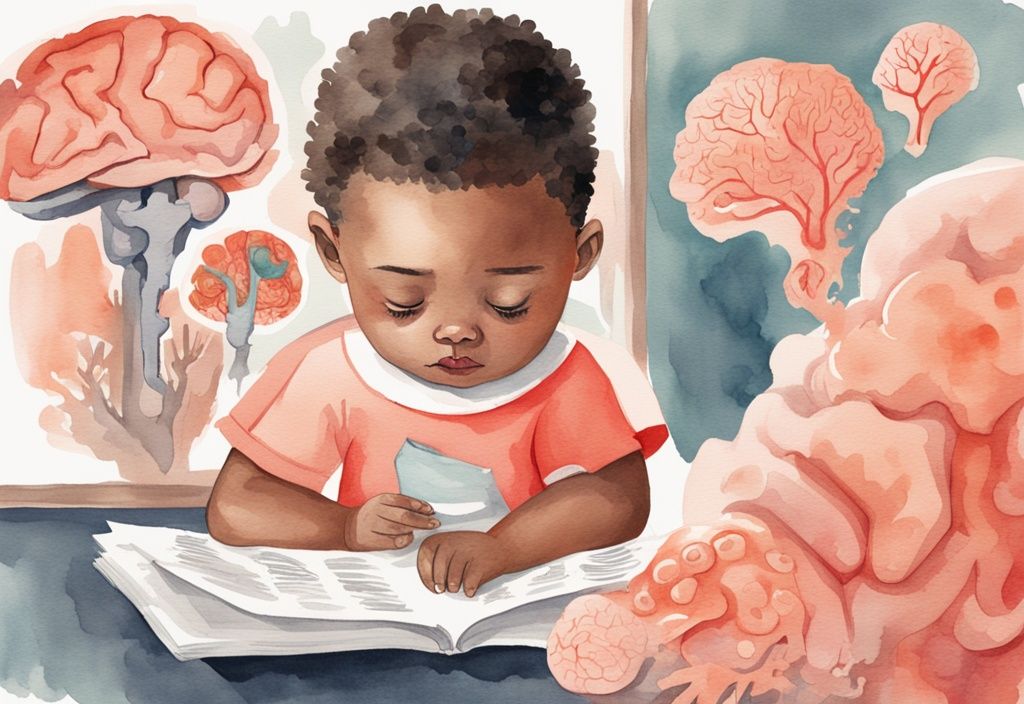Did you know that Shaken Baby Syndrome (SBS) is a leading cause of child abuse fatalities in children under one year old? It’s a chilling fact, but one that we, as parents and caregivers, must confront. This is a critical issue that we all need to understand and prevent.
In this article, we’ll delve into the signs, diagnosis, and treatment of SBS. We’ll also emphasize the importance of awareness and education. Recognizing the symptoms and understanding the risks are vital steps in prevention.
By equipping ourselves with this knowledge, we can help protect our little ones and prevent this tragic syndrome from occurring. Because every child deserves a safe and loving environment to grow and thrive in.
Defining Shaken Baby Syndrome
Understanding what is the shaken baby syndrome is vital for every parent and caregiver. This serious form of child abuse happens when an infant or toddler is violently shaken, leading to potentially devastating outcomes. Known by several names—like abusive head trauma or whiplash shaken infant syndrome—this harmful action causes the child’s brain to move back and forth within the skull. The result? Bruising, swelling, and bleeding that can have long-lasting effects. Let’s dive deeper into what it means and how we can protect our little ones.
What Does it Mean?
Picture this: a tiny, delicate brain inside a small skull, moving violently due to shaking. That’s what happens in Shaken Baby Syndrome (SBS). It’s not just a medical term; it’s a heartbreaking reality for many families. This syndrome is a reminder of how fragile our little ones are and the importance of handling them with utmost care and love. As parents, understanding what is the shaken baby syndrome can empower us to prevent such tragedies.
Who are the Most Vulnerable?
Our smallest treasures, especially those under one year old, are the most vulnerable to SBS. Most cases involve babies between two and eight months old, but remember, children up to five years old can be affected. Why are they so at risk? Their neck muscles are still developing, and their heads are disproportionately larger compared to their bodies. This combination makes them particularly susceptible to injury from violent shaking.
It’s a sobering thought, but it also highlights why awareness and prevention strategies are so crucial. As a community of caring parents, we can support each other in spreading the word and protecting our precious little ones. Let’s focus on nurturing environments where our children can grow safely and happily, free from harm.
Identifying Shaken Baby Syndrome: Symptoms and Signs
Understanding what is the shaken baby syndrome is essential for early detection and intervention. This condition, often resulting from the violent shaking of an infant, can have serious consequences. Let’s explore the common indicators and internal injuries associated with this syndrome, so you can be better prepared to recognize and respond to these signs.
Common Indicators
Oh, the joys and challenges of parenting! As a mom, I know how easy it is to overlook certain behaviors, thinking they’re just part of the normal baby package. But knowing what is the shaken baby syndrome can truly make a difference. If your little one is unusually irritable or struggling to stay awake, it might seem like typical baby stuff, right? But when these are paired with breathing issues, poor eating, and tremors, it’s time to pay closer attention. More alarming symptoms like vomiting, pale or bluish skin, and seizures demand immediate action. And remember, sometimes there are no visible signs, so keep an eye on any sudden changes in your child’s behavior.

Internal Injuries to Look Out For
Now, let’s talk about the more hidden side of what is the shaken baby syndrome—internal injuries. These can be quite serious, often stemming from the forceful shaking itself. Brain and eye bleeding are common but not always visible without a doctor’s check-up. Spinal cord damage and fractures can also occur, adding to the complexity of the situation. In the worst cases, these injuries can lead to permanent issues like brain damage, blindness, or hearing loss. Learning difficulties and physical disabilities might show up later, and seizures could become a recurring nightmare. Tragically, the most severe cases can result in death, highlighting the critical need for early recognition and intervention.
Diagnosing Shaken Baby Syndrome
Understanding what is the shaken baby syndrome is essential for accurate diagnosis, and it’s a topic that brings both concern and complexity. This syndrome, often challenging to detect, can present symptoms that mimic other conditions, leaving even experienced medical professionals puzzled. Sometimes, there are no visible external injuries, which adds another layer of difficulty. However, when a child shows signs of severe brain injuries or retinal hemorrhages without any apparent external trauma, doctors may start to suspect shaken baby syndrome. This suspicion arises from a mix of symptoms and the absence of other explanations for the child’s condition.
Challenges in Detecting the Syndrome
As a parent, the thought of shaken baby syndrome can be overwhelming. The reality is, diagnosing this condition isn’t straightforward. Symptoms can be misleading, resembling those of other illnesses or injuries. Often, there are no visible signs, which makes it even more challenging for doctors to pinpoint the issue. Yet, when certain symptoms like severe brain injuries or retinal hemorrhages appear without an obvious cause, doctors might suspect shaken baby syndrome. It’s a tough call, but one that’s made by piecing together various clues.
Methods Used in Diagnosis
When it comes to diagnosing what is the shaken baby syndrome, doctors use several methods to get to the bottom of things. It usually starts with a thorough physical exam and a detailed look at the child’s medical history. Imaging tests, like CT scans or MRIs, play a crucial role. These tests help doctors see internal injuries, such as brain swelling or bleeding, which are telltale signs of shaken baby syndrome. By using these diagnostic tools, healthcare providers can make informed decisions and ensure that affected children receive the care they need.
Treatment and Recovery from Shaken Baby Syndrome
When exploring what is the shaken baby syndrome, it’s essential to grasp the importance of both immediate and long-term care. The journey through Shaken Baby Syndrome (SBS) involves critical steps that require a compassionate and informed approach.
Immediate Medical Interventions
Now, let’s dive into the urgency of immediate medical interventions. Imagine, if you will, the stress and fear of realizing your little one might be affected by SBS. It’s a heart-stopping moment, but knowing the right steps can make all the difference. Healthcare professionals jump into action, focusing first on stabilizing your baby’s condition. This might mean emergency surgery to stop brain bleeding and reduce intracranial pressure. It’s a whirlwind of activity, but every step is vital to protect your child. And let’s not forget, other injuries from the shaking, like fractures or spinal cord issues, need special attention too. It’s all about ensuring your baby’s safety and health right from the get-go.
Long-term Rehabilitation and Care
But understanding what is the shaken baby syndrome doesn’t stop at immediate care. The road to recovery is a marathon, not a sprint. Many children face developmental hurdles, and that’s where long-term rehabilitation steps in. Picture a team of dedicated professionals working together, like a well-oiled machine, to support your child’s growth. Physical therapy helps improve those tiny motor skills, while occupational therapy focuses on making daily life a bit easier. And then there’s speech therapy, a crucial ally in overcoming communication challenges. It’s a comprehensive approach, aiming to unlock your child’s full potential.

Remember, this journey is not one you take alone. It’s a team effort, with caregivers and healthcare professionals by your side, offering unwavering support. Together, you navigate the complexities of SBS, celebrating every small victory along the way. It’s all about realistic, compassionate care, focusing on the joys and challenges of parenting with genuine empathy.
Preventing Shaken Baby Syndrome
Understanding what is shaken baby syndrome is essential for every parent and caregiver. This serious condition, caused by violently shaking an infant, can lead to devastating consequences. Let’s explore ways to prevent it by spreading awareness and managing stress effectively.
Spreading Awareness and Education
First things first, knowing what is shaken baby syndrome can make all the difference. Imagine being part of a community where everyone is informed about the dangers of shaking a baby. Many organizations are out there, tirelessly working to educate parents and caregivers. They offer resources that are not only informative but also easy to understand, helping us all grasp the severe impact of such actions. By sharing this knowledge, we can collectively aim to reduce the occurrence of shaken baby syndrome and keep our little ones safe.
Effective Stress Management for Caregivers
Now, let’s chat about stress—something every caregiver knows well. Babies cry, and sometimes they cry a lot. It’s their way of communicating, and it can be overwhelming. But remember, taking a breather is okay. When you’re feeling swamped, step back for a moment. Call a friend, take a deep breath, or just hum a tune. Simple techniques like gentle rocking, singing, or offering a pacifier can work wonders in soothing a crying baby.
It’s all about recognizing when you’re stressed and addressing it before it builds up. By managing stress effectively, we can avoid the dangerous impulse to shake a baby. After all, the safety and well-being of our infants are what truly matter. So, let’s embrace these strategies and support each other on this parenting journey. You’re not alone, and together, we can make a difference.
Frequently Asked Questions
In this section, we’re diving into some common questions about what is the shaken baby syndrome. Let’s explore the signs, causes, prevention methods, and what to do if you suspect it.
What are the Early Signs of Shaken Baby Syndrome?
Oh, dear, recognizing the early signs of shaken baby syndrome can be a real lifesaver. You might notice your little one being unusually irritable or having trouble staying awake. Breathing difficulties and poor eating can also be red flags. Trust your instincts, and if something feels off, it’s always better to seek medical help sooner rather than later.
Can Shaken Baby Syndrome Occur Accidentally?
Here’s the thing: shaken baby syndrome doesn’t happen by accident. It stems from violent shaking, often when a caregiver is overwhelmed or frustrated. Gentle activities like playful swinging or those little tumbles that happen during playtime aren’t the culprits. It’s important to remember that accidents in play are normal and not a cause for this syndrome.

How Can Caregivers Prevent Shaken Baby Syndrome?
Prevention is all about being informed and prepared. As caregivers, educating ourselves about the dangers of shaken baby syndrome is key. Embrace stress management strategies—take those much-needed breaks and reach out for support when you’re feeling frazzled. Remember, it’s okay to ask for help. We’re all in this together, and taking care of yourself is just as important as caring for your baby.
What to Do if Shaken Baby Syndrome is Suspected?
If you ever suspect shaken baby syndrome, don’t hesitate to seek immediate medical attention. Early intervention can make a significant difference in managing symptoms and safeguarding your child’s health. Trust yourself, and know that acting quickly is a powerful step in protecting your little one.
Conclusion
Understanding what is shaken baby syndrome is so important, especially when we consider how preventable it truly is. This severe form of child abuse happens when an infant or toddler is violently shaken, leading to injuries that can be life-threatening. The impact of shaken baby syndrome can be heartbreaking, often resulting in permanent brain damage, physical disabilities, or even death. But here’s the silver lining: it is entirely preventable.
Raising awareness and providing education are key steps in preventing shaken baby syndrome. It’s essential for parents and caregivers to know the dangers of shaking a baby. By understanding these risks, caregivers can take proactive steps to protect their little ones. Educational campaigns and resources are crucial in spreading this knowledge, ensuring caregivers are well-prepared to handle stressful situations without resorting to harmful actions.
Let’s talk about stress management, another critical piece of the puzzle in preventing shaken baby syndrome. Caregivers often find themselves in overwhelming situations, especially when a baby is crying non-stop. It’s important to remember that crying is a baby’s way of communicating. By using effective stress management strategies, like taking breaks and seeking support, caregivers can avoid the frustration that might lead to harmful actions.
If shaken baby syndrome is suspected, getting medical help quickly is vital. Early detection and treatment can make a big difference in the outcomes for affected children. Immediate medical care, followed by long-term rehabilitation and support, can help manage symptoms and aid in the child’s recovery.
In conclusion, understanding what is shaken baby syndrome and taking preventive measures are essential for safeguarding the well-being of our precious infants and toddlers. Through awareness, education, and effective stress management, caregivers can create a safe environment for their children, ensuring their healthy development and preventing the tragic consequences of shaken baby syndrome. Remember, you’re not alone in this journey, and together, we can make a difference.


